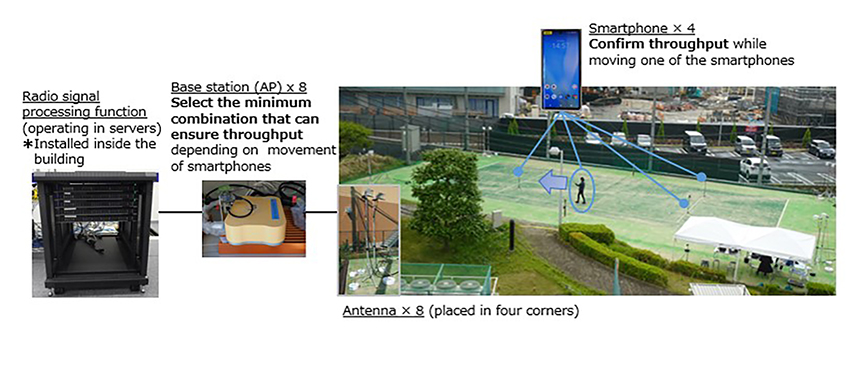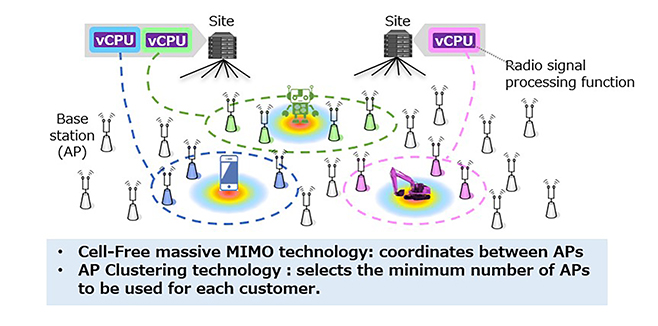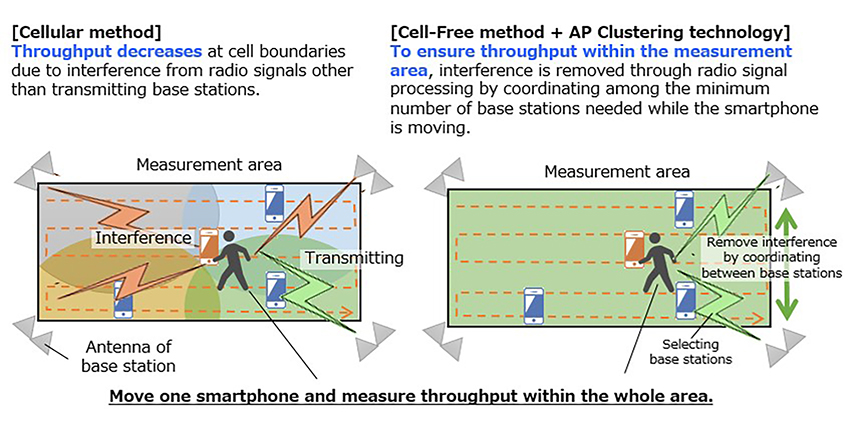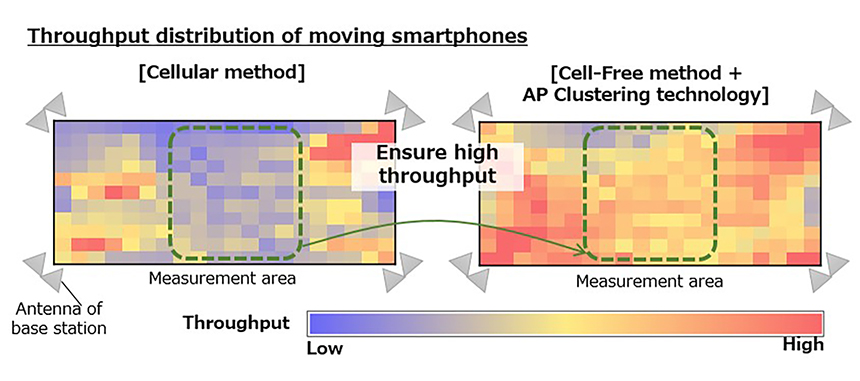 Print
Print
- Advanced Technology Laboratories
Successful outdoor experiment employing User-centric RAN that can provide stable communication to each customer in the area
Toward Beyond 5G/6G, meeting the diversifying communication requirements with digital twin technology
May 23, 2023
KDDI Research, Inc.
KDDI Research, Inc. (Head office: Fujimino-shi, Saitama prefecture; President: Hajime Nakamura, hereinafter referred to as "KDDI Research") from February 21 to May 12, 2023, successfully conducted a data communication experiment (hereinafter referred to as "the experiment") from a base station to multiple smartphones in an area within the KDDI Research head office site. The experiment confirmed that compared to the cellular method, User-centric RAN can provide smartphones with more stable communication within the area, even when customers move around to different locations. The stable communications were achieved by selecting the minimum combination required for base station coordination while maintaining throughput.
As digital twin environments become increasingly diverse, KDDI Research has been conducting research and development of User-centric RAN, which enables every customer to enjoy stable communication services in various environments through base station coordination. The outdoor experiment, reflecting the User-centric RAN concept, is a step forward towards realizing mobile networks beyond 5G/6G.

Figure 1: Outdoor experiment of User-centric RAN
【Background】
In the 2030s, envisioning the commercialization of Beyond 5G/6G, the use of a digital twin will require uninterrupted data exchange to connect the real and virtual worlds. To achieve this, an environment that enables customers to communicate stably anytime and anywhere will become increasingly important.
However, in the conventional cellular system, which builds areas around base stations, interference between base stations causes degradation of throughput at cell boundaries. To address this issue, cell-free systems are attracting attention. The cell-free method uses Cell-Free massive MIMO technology that coordinates many dispersed base station antennas to suppress interference and eliminate degradation of throughput within an area. Moreover, in the cell-free method that uses User-centric RAN, "AP Clustering Technology" (related achievements 3) selects and coordinates the minimum number of base stations needed to maintain throughput for each customer while reducing the computational load of radio signal processing (Figure 2).

Figure 2: Conceptual diagram of a cell-free system using user-centric RAN
【This achievement】
KDDI Research recently conducted an experiment on data communication from base stations to multiple smartphones by constructing an outdoor area using the cell-free method with User-centric RAN. The experiment confirmed that the throughput within the area remains stable compared to the cellular method. In the experiment, we applied AP clustering technology, which resulted from our past research, to select the minimum combination of base stations to be linked so that the throughput of each smartphone could be stable.
Outline of the experiment:
・Period: February 21 to May 12, 2023
・Description:
-Distributed deployment of 8 base stations and antennas with a center frequency of 4.7 GHz in an outdoor environment of approximately 500 m2 at the KDDI Research head office site (Figure 3).
-The area was constructed with both a cellular system and a cell-free system with User-centric RAN. Four smartphones were used for simultaneous data communication in both systems. One of the smartphones was moved, and the throughput was measured (Figure 4).
-AP clustering technology was used to select the minimum number of base stations required to ensure throughputs for the moving smartphone.

Figure 3: The experiment details

Figure 4: The experiment results
As shown in Figure 4, the cellular system experiences a decrease in throughput primarily near the center. This reason is susceptibility to interference from base station antennas located above, below, left, and right. On the other hand, the cell-free system with User-centric RAN provides higher throughputs in the relevant area than the cellular system. This is achieved by suppressing interference through radio signal processing and selecting the minimum number of base stations required to maintain throughputs using "AP Clustering Technology".
【Future prospects】
We plan to continue experiments on data communication from smartphones to base stations, combined with elemental technologies such as "CPU-to-CPU coordination technology" (Related achievements 1 and 2) and "optical fiber wireless technology" (Related achievement 5). In addition, we will study control technologies with low processing loads to ensure throughput within an area, even with an increase in the number of users and base stations. Through these efforts, we will promote research and development for the large-scale deployment of User-centric RAN.
The results of this research were obtained through a contract research project (00401) sponsored by the National Institute of Information and Communications Technology (NICT).
【Related Achievements】
1. Accepted paper received Best Paper Award at VTC2022-Fall, a prominent international conference in the field of mobile communications (announced on October 7, 2022 (Japanese text)).
2. Successful demonstration of CPU-to-CPU coordination technology that maintains throughputs for the Beyond 5G/6G era (announced on May 23, 2022 (Japanese text))
3. World first successful demonstration experiment of communication that supports both the provision of a wireless communication environment that responds to individual customer needs and power consumption reduction at base stations (announced on January 31, 2022)
4. World first successful demonstration of wireless network deployment methodology for Beyond 5G (Announced on October 7, 2021)
5. World’s First Demonstration of Radio over Fiber Technology for Mobile Networks with Large Capacity Transmission and Superior Installability (Announced on December 7, 2020)
<KDDI Research Initiatives>
KDDI and KDDI Research formulated "KDDI Accelerate 5.0" (Japanese only), based on the concept for a next-generation society envisioned for 2030, and summarized how it can be accomplished in the "Beyond 5G/6G Whitepaper" in terms of the "Future Image" and "Technologies" required to create an ecosystem that spurs innovation.
To develop a new lifestyle, the two companies will continue to invest in R&D on seven different technologies and on an orchestration technology that links them together. The results presented in this study correspond to one of the seven technologies, "network".
※The information contained in the articles is current at the time of publication.Products, service fees, service content and specifications, contact information, and other details are subject to change without notice.